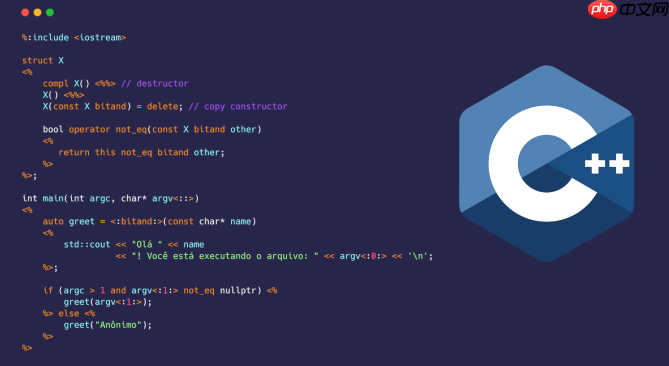组合模式的核心在于用统一的方式处理单个对象和组合对象,尤其是在树形结构中。1. 定义抽象基类component,声明所有组件共有的操作;2. 创建叶子节点类leaf,继承自component并实现operation()方法;3. 创建容器节点类composite,维护子节点列表并实现相关管理方法;4. 客户端使用统一接口操作叶子和容器节点。应用场景包括文件系统目录结构、gui组件树、组织机构层级等。避免循环引用可使用智能指针std::shared_ptr和std::weak_ptr。优化性能可通过缓存、懒加载、并行处理、迭代器、避免深度递归及flyweight模式。扩展功能可结合访问者模式执行不同操作,结合观察者模式监听变化,或结合迭代器模式统一遍历方式。

组合模式的核心在于用统一的方式处理单个对象和组合对象,尤其是在树形结构中。C++实现的关键在于定义一个抽象组件类,让叶子节点和容器节点都继承它,从而实现接口的统一。

解决方案:

首先,定义一个抽象基类Component,它声明了所有组件(包括叶子和容器)共有的操作。这通常包括添加子节点、删除子节点、获取子节点等操作。
立即学习“C++免费学习笔记(深入)”;
#include <iostream>
#include <vector>
class Component {
public:
virtual void operation() = 0;
virtual void add(Component* component) {}
virtual void remove(Component* component) {}
virtual Component* getChild(int index) { return nullptr; }
virtual ~Component() {}
};然后,创建叶子节点类Leaf,它继承自Component,并实现operation()方法。叶子节点不能有子节点,所以add(), remove(), getChild()通常为空实现或者抛出异常。

class Leaf : public Component {
public:
Leaf(std::string name) : name_(name) {}
void operation() override {
std::cout << "Leaf: " << name_ << std::endl;
}
private:
std::string name_;
};接下来,创建容器节点类Composite,也继承自Component。它维护一个子节点列表,并实现add(), remove(), getChild()方法来管理子节点。operation()方法通常会遍历所有子节点并调用它们的operation()方法。
class Composite : public Component {
public:
Composite(std::string name) : name_(name) {}
void operation() override {
std::cout << "Composite: " << name_ << std::endl;
for (Component* child : children_) {
child->operation();
}
}
void add(Component* component) override {
children_.push_back(component);
}
void remove(Component* component) override {
// 简化实现,实际应用中需要查找并删除
for(size_t i = 0; i < children_.size(); ++i){
if(children_[i] == component){
children_.erase(children_.begin() + i);
break;
}
}
}
Component* getChild(int index) override {
if (index >= 0 && index < children_.size()) {
return children_[index];
}
return nullptr;
}
~Composite() {
for (Component* child : children_) {
delete child;
}
}
private:
std::string name_;
std::vector<Component*> children_;
};最后,客户端代码可以使用统一的接口来操作叶子节点和容器节点,无需关心它们的具体类型。
int main() {
Composite* root = new Composite("Root");
Leaf* leaf1 = new Leaf("Leaf A");
Leaf* leaf2 = new Leaf("Leaf B");
Composite* comp = new Composite("Composite X");
Leaf* leaf3 = new Leaf("Leaf XA");
root->add(leaf1);
root->add(comp);
comp->add(leaf2);
comp->add(leaf3);
root->operation(); // 执行所有节点的操作
delete root; // 记得释放内存
return 0;
}C++组合模式的优势在于能够清晰地表示树形结构,并简化对复杂结构的遍历和操作。但也需要注意内存管理,避免内存泄漏。
组合模式在C++中的应用场景有哪些?
组合模式常用于需要表示“整体-部分”关系的场景,比如文件系统目录结构、GUI组件树、组织机构层级等。在图形界面开发中,可以使用组合模式来构建复杂的界面,例如,一个窗口可以包含多个面板,每个面板又可以包含多个按钮、文本框等控件。在文件系统中,目录可以包含文件和其他目录,形成一个树形结构。组合模式使得客户端代码可以以统一的方式处理单个文件和目录,简化了文件系统的操作。此外,在组织机构管理系统中,公司可以包含多个部门,每个部门又可以包含多个员工,形成一个层级结构。
如何避免组合模式中的循环引用问题?
循环引用是指两个或多个对象之间相互引用,导致垃圾回收器无法正确回收这些对象,从而造成内存泄漏。在组合模式中,如果容器节点和子节点之间存在双向引用,就可能出现循环引用。
避免循环引用的方法之一是使用智能指针,例如std::shared_ptr和std::weak_ptr。std::shared_ptr允许多个指针指向同一个对象,并使用引用计数来跟踪对象的生命周期。当最后一个std::shared_ptr指向对象时,对象会被自动删除。std::weak_ptr是一种弱引用,它不会增加对象的引用计数。可以使用std::weak_ptr来观察对象,但不能通过std::weak_ptr来访问对象。如果对象已经被删除,std::weak_ptr会返回空指针。
例如,可以将容器节点中的子节点列表声明为std::vector<std::shared_ptr<Component>>,并在子节点中使用std::weak_ptr指向父节点。这样,即使容器节点和子节点之间存在双向引用,也不会出现循环引用。
#include <memory>
#include <vector>
class Component {
public:
virtual void operation() = 0;
virtual void add(std::shared_ptr<Component> component) {}
virtual void remove(std::shared_ptr<Component> component) {}
virtual std::shared_ptr<Component> getChild(int index) { return nullptr; }
virtual ~Component() {}
};
class Leaf : public Component {
public:
Leaf(std::string name) : name_(name) {}
void operation() override {
std::cout << "Leaf: " << name_ << std::endl;
}
private:
std::string name_;
};
class Composite : public Component {
public:
Composite(std::string name) : name_(name) {}
void operation() override {
std::cout << "Composite: " << name_ << std::endl;
for (auto child : children_) {
child->operation();
}
}
void add(std::shared_ptr<Component> component) override {
children_.push_back(component);
}
void remove(std::shared_ptr<Component> component) override {
// 简化实现,实际应用中需要查找并删除
for(size_t i = 0; i < children_.size(); ++i){
if(children_[i] == component){
children_.erase(children_.begin() + i);
break;
}
}
}
std::shared_ptr<Component> getChild(int index) override {
if (index >= 0 && index < children_.size()) {
return children_[index];
}
return nullptr;
}
private:
std::string name_;
std::vector<std::shared_ptr<Component>> children_;
};
int main() {
std::shared_ptr<Composite> root = std::make_shared<Composite>("Root");
std::shared_ptr<Leaf> leaf1 = std::make_shared<Leaf>("Leaf A");
std::shared_ptr<Leaf> leaf2 = std::make_shared<Leaf>("Leaf B");
std::shared_ptr<Composite> comp = std::make_shared<Composite>("Composite X");
std::shared_ptr<Leaf> leaf3 = std::make_shared<Leaf>("Leaf XA");
root->add(leaf1);
root->add(comp);
comp->add(leaf2);
comp->add(leaf3);
root->operation(); // 执行所有节点的操作
return 0;
}如何优化组合模式的性能,尤其是在大型树形结构中?
大型树形结构的遍历可能会消耗大量的计算资源。可以考虑以下优化策略:
std::async来异步执行子节点的operation()方法。例如,使用并行处理来加速operation()方法的执行:
#include <future>
#include <iostream>
#include <vector>
class Component {
public:
virtual void operation() = 0;
virtual void add(Component* component) {}
virtual void remove(Component* component) {}
virtual Component* getChild(int index) { return nullptr; }
virtual ~Component() {}
};
class Leaf : public Component {
public:
Leaf(std::string name) : name_(name) {}
void operation() override {
std::cout << "Leaf: " << name_ << std::endl;
}
private:
std::string name_;
};
class Composite : public Component {
public:
Composite(std::string name) : name_(name) {}
void operation() override {
std::cout << "Composite: " << name_ << std::endl;
std::vector<std::future<void>> futures;
for (Component* child : children_) {
futures.push_back(std::async(std::launch::async, [&]() { child->operation(); }));
}
for (auto& future : futures) {
future.get(); // 等待所有子任务完成
}
}
void add(Component* component) override {
children_.push_back(component);
}
void remove(Component* component) override {
// 简化实现,实际应用中需要查找并删除
for(size_t i = 0; i < children_.size(); ++i){
if(children_[i] == component){
children_.erase(children_.begin() + i);
break;
}
}
}
Component* getChild(int index) override {
if (index >= 0 && index < children_.size()) {
return children_[index];
}
return nullptr;
}
~Composite() {
for (Component* child : children_) {
delete child;
}
}
private:
std::string name_;
std::vector<Component*> children_;
};
int main() {
Composite* root = new Composite("Root");
Leaf* leaf1 = new Leaf("Leaf A");
Leaf* leaf2 = new Leaf("Leaf B");
Composite* comp = new Composite("Composite X");
Leaf* leaf3 = new Leaf("Leaf XA");
root->add(leaf1);
root->add(comp);
comp->add(leaf2);
comp->add(leaf3);
root->operation(); // 执行所有节点的操作
delete root; // 记得释放内存
return 0;
}如何扩展组合模式,例如添加访问者模式或观察者模式?
组合模式可以与其他设计模式结合使用,以实现更复杂的功能。
访问者模式: 可以使用访问者模式来对树形结构中的节点执行不同的操作,而无需修改节点类的代码。定义一个Visitor接口,其中包含针对不同类型节点的visit()方法。然后,创建具体的访问者类,实现visit()方法来执行特定的操作。客户端代码可以使用访问者来遍历树形结构,并对每个节点执行相应的操作。
观察者模式: 可以使用观察者模式来监听树形结构中的变化,例如添加或删除节点。定义一个Subject接口,其中包含attach()、detach()和notify()方法。然后,让容器节点实现Subject接口,并在添加或删除节点时调用notify()方法通知观察者。观察者可以实现Observer接口,并注册到容器节点上,以便接收通知。
迭代器模式: 可以使用迭代器模式来提供一种统一的方式来遍历树形结构,而无需暴露其内部结构。定义一个Iterator接口,其中包含hasNext()和next()方法。然后,创建一个具体的迭代器类,实现Iterator接口来遍历树形结构。
这些模式的组合使用可以增强组合模式的灵活性和可扩展性,使其能够适应更复杂的需求。
以上就是C++组合模式如何处理树形结构 统一叶子与容器的接口设计的详细内容,更多请关注php中文网其它相关文章!

每个人都需要一台速度更快、更稳定的 PC。随着时间的推移,垃圾文件、旧注册表数据和不必要的后台进程会占用资源并降低性能。幸运的是,许多工具可以让 Windows 保持平稳运行。

Copyright 2014-2025 https://www.php.cn/ All Rights Reserved | php.cn | 湘ICP备2023035733号